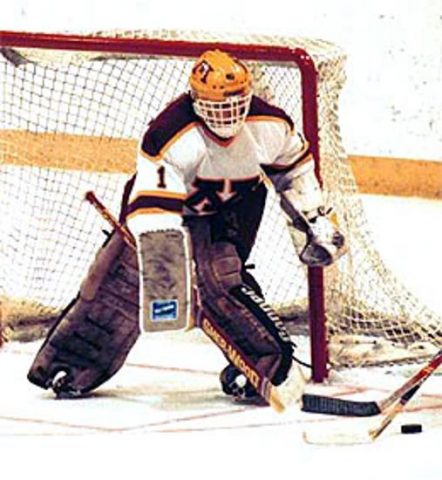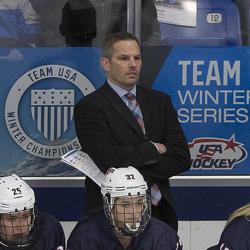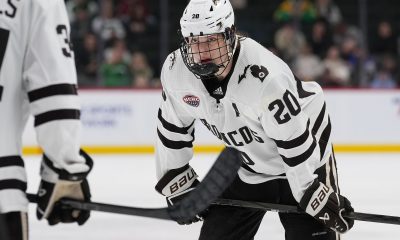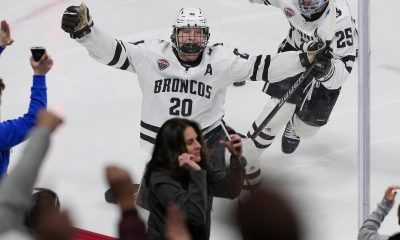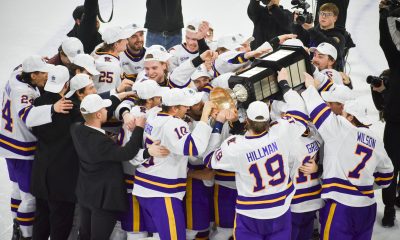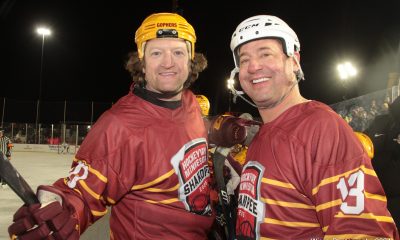Division I Men
From Gold Medal to Maroon and Gold?
Stauber wants to make Gophers ‘most fun team to watch in college hockey’
-
by
John Gilbert
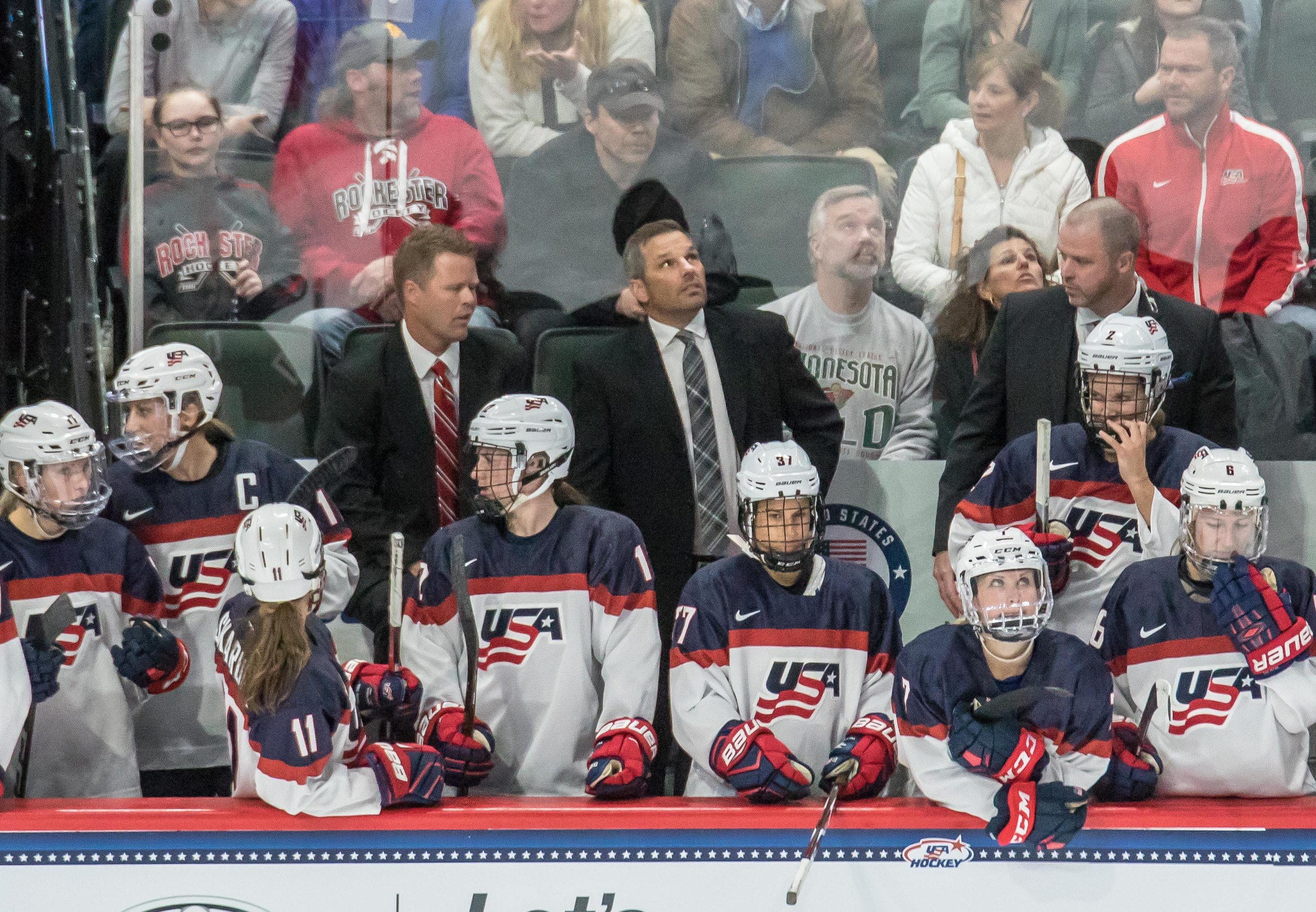
Gold-medal winning Team USA women’s coach Robb Stauber looks at a replay on the Xcel Energy Center scoreboard during a Dec. 3, 2017 game against Team Canada. The former University of Minnesota goaltender now has his sights set on the his alma mater’s head coaching vacancy. (MHM Photo / Jonny Watkins)
Stauber wants to make Gophers ‘most fun team to watch in college hockey’
All Robb Stauber wants from his alma mater is an interview
When you talk to Stauber, his intensity, honesty and determination are readily apparent, and you have to believe him when he says he would love the opportunity to lift the University of Minnesota Golden Gopher hockey program back up to where it belongs — as the elite college hockey program in the country.
“This program is in trouble, and I’m not sure they know it,” Stauber said. “First of all, I hope I can get an interview. If I do, I will absolutely say what I believe. There is not a chance in hell I would say something I don’t believe in, just to get the job. I will explain what I would do — that we will unleash the talent to go north, south, diagonally, and all over, and do things that are very different to keep possession of the puck, and make the Gophers the most fun team to watch in college hockey.”
That’s the same attitude he brought to the job as head coach of Team USA’s women’s team, which he led down his own forceful and controversial path with a revolutionary style that swept the U.S. to the gold medal at the Winter Olympics in South Korea.
Don Lucia decided to retire early this week, after 19 years of coaching the Gophers to the first and only two NCAA championships they’d won since Herb Brooks won three national titles in an amazing seven-year run through the 1970s, ending a gap of 23 years.
The line of potential successors has been immediate, long, and growing, there will be major campaigns to support some of them.
Robb Stauber will be the one off to the side, easy to overlook, possibly, but armed with the exact outlook and historic perspective to do what many think is impossible: unifying the scattered M-Club hockey boosters who have turned away from the program, reuniting the entire state’s high school structure behind the Gophers, and, without even intending to, rekindling the torch that Herbie not only carried, but created.
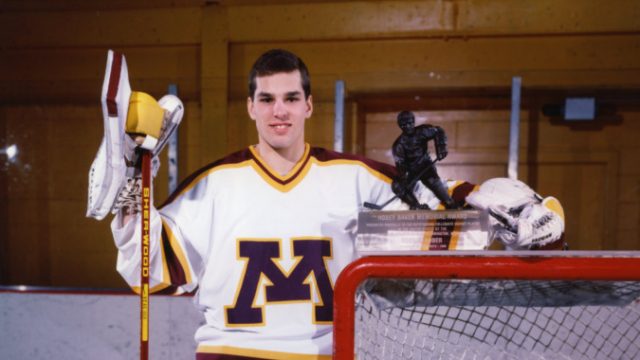
In 1988, Stauber was the first goaltender to receive the Hobey Baker Award given to the player deemed to be the best in college hockey that season. (Photo courtesy of University of Minnesota Athletics)
Stauber’s resume is richer in quality than quantity, since coming from Duluth Denfeld High School to the ‘U,‘ where he became the first goaltender to ever win the Hobey Baker Award back in 1988, and dominated WCHA goaltending statistics while leading Minnesota to the NCAA Frozen Four in all three years he played. He played on some Team USA outfits, and played for the Los Angeles Kings in the NHL before becoming a highly decorated goaltending coach at Minnesota, UMD, in running his own hockey schools, and by coaching goaltenders for USA Hockey. Eight years after starting to coach Team USA goalies, Stauber was offered the chance to be head coach. Ironic timing in a game that has become more primitive in its evolution, and lost Stauber as a fan.
“I can’t stand watching hockey,” Stauber said. “It is so bad, that I have gotten sick watching dump-and-chase hockey. Four years ago, I was sitting upstairs at the Women’s Olympic finals, and we were up 2-0 with 14 minutes left. Our plan was to dump the puck in to protect the lead, and Canada scored twice to tie it and beat us in overtime.
“I said, ‘I can’t stay involved if this is how we’re going to play.’
“It was a miracle I got the U.S. coaching job,” Stauber added. “Reagan Carey, our manager, had been sitting upstairs with me watching the team play for years. I always talked to her about how we could do things differently. She recognized that we were doing some old-school things, and she decided to take a chance on me.”
Stauber made changes in personnel, including the addition of Maddie Rooney, the youngest player on the team, as one of three goaltenders. The current UMD star started all but one game in South Korea, including the brilliant performance in the gold medal shootout game against Canada.
But mostly, he patiently but surely changed the ingrained, instinctive style of every player on the team into his own concept, which greatly resembles the regrouping puck-control style of the Russians, and of Herb Brooks.
“I am really disappointed that the media never even asked us about the transition in the way we played, and the players have never truly gotten the credit for what we went through,” said Stauber. “They had all come from good college programs, and they were all used to playing the traditional style, which meant getting out of your zone and then dumping the puck into the other end.
“We wanted them to bring the puck back and regrouping, sometimes more than once bringing the puck back out of the offensive zone to keep possession. There was a lot of resistance, and a lot of pain transforming what they all believed in to what we wanted to do. The players would complain, ‘what about scoring?’ and I’d say don’t worry about scoring; if we keep the puck, the scoring will come. We looked like a peewee team sometimes while we were making the transition in style.”
The style of creative hockey Stauber believes in is in stark contrast to traditional North American hockey, which has become a simplistic game of chipping the puck out of the zone, and sending it in deep to the offensive zone, hoping to forecheck for a turnover and a scoring chance. So uniform is the game these days that if you listen to broadcast analysts their only assessment is: “They’ve got to get the puck in deep, and get pucks and bodies to the net.”
Stauber believes otherwise, and he is too young to realize that Brooks harbored the same beliefs, privately, before experimenting with them during his years with the Gophers.
“I was always enthralled with what Herbie was able to accomplish at Minnesota, and it made me want to go there as I was growing up,” Stauber said. “You look back at the Russian teams back then, and they were without question the best at skill and imagination of how to play the game. They don’t play dump-and-chase; they keep possession of the puck until they can create a good scoring chance. Herbie’s style was similar, and when he went to coach the New York Rangers, I watched them on TV every time I had the chance.
“In 1989, I got the chance to play for the U.S. along with John Vanbiesbrouck, and I got the chance to start against the Russians in what was Igor Larionov’s last World Championships. They had guys like Fetisov and Krutov and I think they started me so they could save Vanbiesbrouck. I didn’t sleep the night before. I’d studied them, and I knew they would pass up scoring plays to set up back-door plays, and I knew I would have to adjust my game because they could make a goalie look silly. I think we lost 3-1, but it was 2-1 late.”
Believing in a system that is alien to North American players was a bold gamble. Brooks did it with his hand-selected team for 1980, and while the changeover was virtually ignored by the media who don’t really understand the game’s nuances, Stauber was more concerned with getting all his players on board. His staff included Brett Strot, who had been Stauber’s trusted ally since they were teammates and roommates in Gopher days, and Paul Mara, a high school coach in Boston who joined fairly late.
“Paul got so excited about what we were trying to do that he’d call people and say they wouldn’t believe what we were doing. Coaching women is a lot different than coaching men. The women will listen to what you say, and do it. It was difficult to get them to go out and improvise, because they were used to being shown by Xs and Os what to do next. We wanted them to keep possession of the puck, but when they got a chance, to go for it and make plays on their own.”
Shades of Herbie’s “Sophisticated pond hockey.”
It wasn’t until late in their development year, December, maybe, that Stauber said he felt that everybody had bought into the whole plan. “If any one of us coaches, or any of the players, didn’t believe in it, it wouldn’t have worked,” he said. “When we got to the point where it was working, some Canadian players gathered to watch us practice. We were doing random regroups, and I’d say to the players that I didn’t know what the Canadian players could learn from it; they can’t figure out what we’re going to do, because we don’t know what we’re going to do.
“We did different drills every day, almost all of them situational, using different forechecks, all intending on getting the players to read what their opponents were doing, and anticipate what they might do. It was great, because no two days of practice were the same, and it forced me to constantly think of what more we might do. There are no drills that can work in every situation.”
Was he surprised at the impressive results the team achieved in South Korea? Was he nervous?
“No, I wasn’t nervous,” he said. “I was happy and excited, but not surprised. We executed the way we practiced, and part of execution is winning. After we won, some good hockey people started to understand what we were doing. But I don’t think the players ever got enough credit from the media, who got all caught up in the hoopla.
“I’m so proud of what we accomplished. After every game, Igor Larionov waited for me and gave me a hug. He was so excited about how we were playing, he said, ‘The girls are smarter than the guys.’ He was genuinely enthused about what we had done. The Russians learned to be the most creative and dynamic team ever in hockey, and I believe part of that was because their lives were controlled so much, that the only place they felt freedom was when they go out on the ice. We take it for granted.”
Interesting. We’re the opposite — we’ve got freedom, but everything on the ice is controlled.
“We had so many good people on the U.S. team, and many of them are going back to college next year,” Stauber said. “They might be miserable when they find out they’re going to have to go back to dump and chase.”
While Stauber hasn’t been associated with either the Gophers men or women since he quit coaching their goaltenders, he’s aware of the drop in attendance, the grumbling about the switch to the Big Ten, and he knows that the “new breed” journalists think any big name coach could come in and succeed, even though many of the most loyal diehards insist otherwise. All the most-mentioned candidates have some assets and liabilities, whether recruiting, or lacking head coaching experience, and some might be lured more by the large salary than any tradition or heritage.
Stauber covers all the bases — including a gold medal for his coaching experience. He’s only offering positives, including the NHL based criticism about the wide, Olympic ice sheet at Mariucci Arena.
“The wide rink? I would make that a home-ice advantage,” said Stauber. “Just this morning, a fellow who followed what we did with Team USA asked me if I’d plan on playing the same way if I got the Gophers men’s job, and I assured him I would. I have no intention of doing anything but what I believe in.
“But first of all, I hope I get an interview.”





